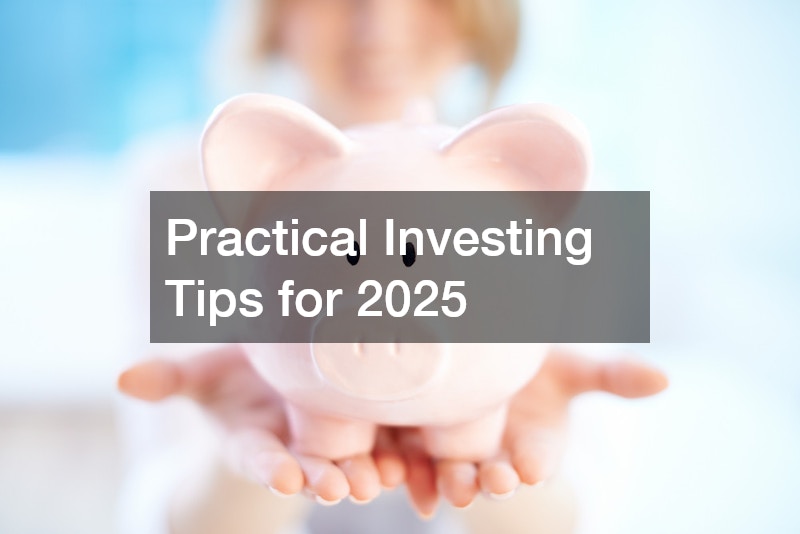

In a rapidly changing financial landscape, seizing the right opportunities and maintaining steady growth can be challenging—even more so heading into 2025. With new technologies emerging at breakneck speed and global events making markets unpredictable, investors need to stay informed and adaptable. While it may feel as if the stakes are higher, there are many steps you can take to remain confident about your portfolio. This blog will guide you through practical investing tips for 2025, exploring various strategies, potential industries, and ways to safeguard and grow your capital in an ever-evolving market. By the end of this article, you’ll be equipped with a clearer perspective on how to navigate the road ahead and make more informed decisions aligned with your risk tolerance, financial goals, and personal interests.

The Evolving Market Dynamics in 2025
Before diving into practical investing strategies, it’s essential to understand the evolving market conditions that will shape 2025. Over the past few years, remote work has become mainstream, and digital technologies have rapidly expanded. This shift has influenced everything from international trade policies to the way companies do business. Tech stocks remain strong, but they’re no longer the only game in town. Investors now look to industries like renewable energy, healthcare innovation, and specialized service providers for both long-term growth and diversification.
Surprisingly, even niche sectors can offer robust opportunities. For example, consider a medical waste company that capitalizes on heightened healthcare requirements. As more medical procedures shift to outpatient clinics and telehealth becomes part of standard care, proper disposal of medical materials remains crucial. Companies operating in this area could enjoy steady demand, especially as environmental regulations tighten. If you’re thinking about broadening your portfolio, look beyond the usual suspects—sometimes, these unconventional market players can deliver stable dividends or sustainable growth.
Diversification Beyond Traditional Assets
One of the cornerstones of practical investing is diversification. Typically, this means balancing equities, bonds, real estate, and perhaps commodities like gold. However, 2025 offers expanded avenues. Cryptocurrencies have become more mainstream, with major institutions adopting blockchain-based technologies. Meanwhile, alternative investments like tokenized real estate, fractional ownership of art, and even niche businesses can help investors distribute risk.
When looking at less conventional options, it can be helpful to model your strategy on how an entrepreneur might diversify revenue streams. Entrepreneurs seldom rely on a single product or service; they branch into multiple areas to mitigate losses if one venture underperforms. From a portfolio perspective, treating your investments like a diversified business ecosystem can protect you during downturns. This is the essence of practical investing: balancing proven blue-chip stocks or stable government bonds with well-researched ventures in emerging niches.

Potential Growth Industries to Watch
2025 is brimming with potential growth industries that could complement your practical investing approach. Here are some sectors and the reasons they might be worth investigating:
Renewable Energy & Clean Tech
Solar, wind, and other green technologies continue to receive both public and private funding. Government incentives for clean energy are likely to increase, making this sector ripe for long-term investments.Biotechnology & Healthcare Innovation
Beyond a medical waste company, consider startups focusing on gene editing, telehealth platforms, and wearable medical devices. The healthcare industry is undergoing a data-driven transformation, and demand for cutting-edge solutions will only grow.AI & Automation
Artificial intelligence has matured significantly in recent years, driving everything from manufacturing to software services. Whether you’re looking at robotics, machine learning solutions for businesses, or sophisticated analytics platforms, AI’s potential remains vast.Specialized Services and Traditional Essentials
While tech is alluring, never underestimate traditional service industries that constantly adapt to modern demands. For instance, emergency plumbers remain vital in any economy—pipes will burst regardless of market conditions. Likewise, a reliable HVAC company that adapts to energy-efficient requirements can have a stable clientele. If you look for businesses with clear, long-term demand (such as plumbing, medical disposal, or property management), you can find recession-resistant opportunities.Travel and Hospitality
After prolonged periods of global uncertainty, leisure and business travel continue to bounce back. A travel concierge service focusing on personalized, high-end travel experiences can thrive in a world where people want curated getaways after being cooped up. Although this sector can be subject to sudden downturns, selective investments in hospitality or tourism-related technology platforms may pay off long-term.
When selecting industries for your portfolio, the key is understanding the growth trajectory and the underlying factors driving it. You can use fundamental and technical analysis, or consult specialized advisors, but the rationale should always tie into your overall goals and risk appetite.
Embracing Technology in Practical Investing
In 2025, ignoring technology when planning your investments can be a costly mistake. Robo-advisors, algorithmic trading, and blockchain-based platforms have streamlined how we buy and sell assets. These tools provide quicker transactions, lower fees, and often a more transparent look at asset performance. More importantly, data analytics have become standard in building practical investing strategies.
But technology’s role in investing goes deeper than trading platforms. AI-driven analytics help in everything from scanning potential real estate deals to evaluating the reliability of a koi pond contractors network. Imagine you’re interested in financing a local koi pond installation business. You can leverage online review aggregators, consumer sentiment analysis, and competitor data to gauge potential returns. The idea is that the right tech tools reduce guesswork, letting you allocate capital more efficiently. In other words, technology has shifted the balance in favor of the investor—if that investor knows how to harness it.

Balancing Risk and Reward
Every investor’s journey includes navigating risks, and practical investing in 2025 is no exception. Risk management demands a clear picture of your financial position, your investment timeline, and your personal risk tolerance. Younger investors might lean toward growth-oriented stocks or even speculative ventures like certain cryptocurrencies, while those approaching retirement typically favor more conservative instruments such as government bonds or dividend-paying stocks.
Nonetheless, risk profiles aren’t just about age. An investor with steady income streams could decide to funnel discretionary funds into higher-risk sectors. Conversely, if you have significant expenses—like mounting legal fees for an aggravated assault attorney, criminal lawyer, or accident attorney (unfortunate though such circumstances might be)—a conservative approach may be more prudent until you stabilize your financial situation. Large, unexpected costs can derail an investment plan, which is why an emergency fund and reliable cash flow are fundamental building blocks of a sustainable strategy.
Importance of Professional Guidance
No matter how experienced you are, there’s always value in seeking professional advice. A seasoned financial advisor can review your holdings, help you rebalance your portfolio, or guide you through complex tax scenarios. While social media and online forums provide a trove of free information, discerning fact from fiction can be challenging.
When selecting professional guidance, be as discerning as you would be when hiring a criminal lawyer or an accident attorney—not all professionals are created equal. Look for advisors with verifiable credentials, transparent fee structures, and a track record aligned with your goals. If possible, choose someone who has navigated multiple market cycles. Their real-world experience helps you adapt to volatility, optimize for tax benefits, and seize hidden opportunities you might otherwise miss.
Remember: good advice is an investment in itself. Cutting corners by relying solely on hearsay or sensational headlines can lead to poor decisions. It’s always better to pay for high-quality guidance than to risk large losses because of incomplete or inaccurate information.

Exploring Alternative Investments
2025 offers a range of alternative investments that go beyond stocks, bonds, or precious metals. While these can be exciting, approach them with caution and thorough research:
Venture Capital and Private Equity
With startup culture expanding globally, there’s a growing number of private companies looking for seed or growth capital. If you have high risk tolerance, investing in a budding tech platform, a local manufacturing outfit, or even a medical waste company can yield substantial returns—but also carries elevated risk. Always vet a company’s financial health, market potential, and leadership team before committing funds.Real Estate Syndications and REITs
Real estate remains a tried-and-true asset class, but the mechanisms of investment have evolved. Real Estate Investment Trusts (REITs) allow small investors to pool resources and own a portion of large-scale properties. Meanwhile, crowdfunding platforms let you invest in specific properties or real estate projects, diversifying your portfolio without the full burden of property management. It’s almost akin to how a travel concierge service might piece together various elements for a traveler’s itinerary: your real estate portfolio can be curated from multiple properties across different regions, all managed by dedicated professionals.Franchise Ownership
Owning a franchise can be lucrative if you find the right brand in a favorable market. Consider essential services like emergency plumbers, HVAC company networks, or air conditioning repair businesses—needs that remain stable in any economic condition. Franchising also comes with a support system, lowering barriers to entry for first-time business owners.Niche Collectibles and Alternative Assets
Beyond fine art and rare wines, emerging categories of collectibles—from digital art (NFTs) to high-end memorabilia—have opened up new channels for speculative investing. Conduct due diligence to gauge liquidity, authenticity, and market demand. While some of these assets can skyrocket in value, others may flounder if they fall out of favor.
Alternative investments can be an excellent component of practical investing if they align with your objectives and risk tolerance. Always do in-depth research or consult a specialist to reduce potential pitfalls.
The Role of Liquidity in Investment Strategy
Liquidity—the ease with which you can convert an asset into cash without significantly affecting its price—often gets overlooked. In 2025, having readily accessible funds is critical. Sudden opportunities might arise, or personal emergencies might demand quick capital. Imagine you needed funds to address a family crisis, pay for legal representation, or to invest in a new opportunity that just popped up. If all your resources are locked into illiquid assets, you could miss out or struggle to cover urgent expenses.
While real estate and private equity can offer substantial returns, they typically lack the liquidity of publicly traded stocks. Balancing liquid and illiquid assets is a cornerstone of practical investing. Keep enough in savings, money market accounts, or short-term bonds so you don’t have to sell assets at an inopportune time. This buffer can also cover immediate needs such as unplanned repairs, healthcare bills, or even a quick pivot to a more promising asset class.
Long-Term vs. Short-Term Strategies
Deciding whether to adopt a short-term or long-term strategy is another aspect of practical investing. Short-term traders focus on capitalizing on price fluctuations, using technical analysis and market sentiment to execute timely trades. While short-term gains can be impressive, this approach demands constant monitoring, emotional discipline, and a solid understanding of market trends.
Long-term investors often aim for steady growth and compounding returns, reinvesting dividends, and ignoring short-term market noise. They might buy shares in companies they believe will thrive over the next decade—whether those are renewable energy pioneers, AI disruptors, or even a well-managed medical waste company. This approach is often less stressful for individuals who have careers, families, or other commitments. The drawback is that you might not capitalize on rapid market movements that can generate quick profits.
Both strategies can work if you maintain discipline, adhere to your risk tolerance, and remain realistic about your time commitments. Some people even adopt a blended strategy: they allocate a portion of their portfolio to long-term holds while using a smaller portion for short-term trades. If you go this route, make sure to keep clear boundaries for each segment of your portfolio to avoid mixing the two and compromising your overall objectives.
Successful investing in 2025 demands a balance of foresight, adaptability, and emotional control. By focusing on practical investing principles—like thorough research, diversification, professional guidance, and a keen understanding of risk—you can remain agile in uncertain times. Embrace technology where it can provide a decisive advantage, yet don’t overlook the significance of time-tested methods like fundamental analysis. Keep an eye on emerging industries—from renewable energy to specialized services like air conditioning repair—while still recognizing the value in traditional sectors.


